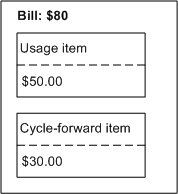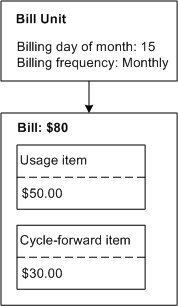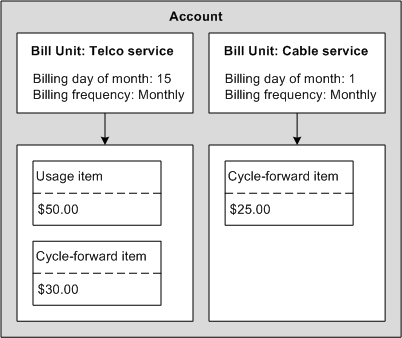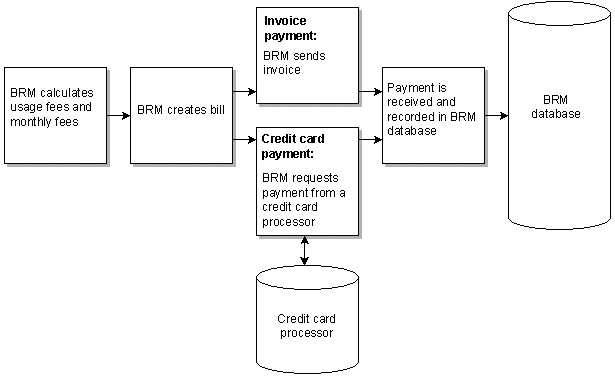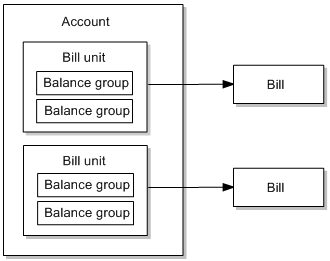4 Overview of Billing
Learn about Oracle Communications Billing and Revenue Management (BRM) billing.
Topics in this document:
For information about setting up and running billing, see BRM Configuring and Running Billing.
About Billing
Billing is the process of compiling charges in a customer's balance and creating a bill. The amount due in the bill is sent to the customer as a payment request.
During the time between bills, a customer's charges are stored in bill items. There are different types of bill items; for example, usage items that store usage charges, and cycle forward items that store recurring charges.
When billing is run, BRM creates a bill. A BRM bill is a /bill object in the BRM database that stores the charges from bill items and all billing information necessary to generate a request for payment.
Note:
The /bill object only stores billing information and is not a request for payment itself. You request payments from customers by creating a payment request.
All accounts in the database, including accounts that do not pay their own bills, have their own /bill objects. The /bill object stores data such as the bill creation date, total charges accumulated in the bill, the amount due from the customer, and the bill due date.
Figure 4-1 shows a bill with two bill items.
Each account includes at least one bill unit that defines the charges from each bill item that belong in a bill. BRM creates one /bill object for each /billinfo object in the BRM database.
Figure 4-2 shows a simplified bill unit and bill relationship. The bill unit defines when and how often to create a bill. The bill includes items that contain the charges collected over the month between bills. A bill is produced for every bill unit.
Billing is based on cycles, usually monthly. Each bill unit has a billing day of month (DOM), which is typically the day of month on which the account is created. For example, if an account is created on May 7, all of its bill units, by default, have the seventh day of the month as their billing DOM.
Note:
For a bill unit, the billing DOM and the accounting DOM are the same day, which is specified in the PIN_FLD_ACTG_CYCLE_DOM field of the /billinfo object.
In addition to the DOM, each bill unit has a billing frequency. For example, if the account is billed monthly, its bills are generated on June 7, July 7, August 7, and so on. Most customer accounts are billed monthly, but you can bill accounts at any monthly interval (for example, bimonthly, quarterly, semiannually, or annually).
An account typically has one bill unit but can have multiple bill units; for example, a bill unit for each service the customer owns. By default, all bill units in an account have the same billing DOM and billing frequency, but you can modify each bill unit to have a different billing DOM and billing frequency. Figure 4-3 shows an account with two bill units. In this example, the bill unit for the cable service has no usage fees.
To create bills, you run billing by running a set of billing scripts, which in turn run billing utilities. For example, the pin_bill_day script runs several billing utilities, including the pin_bill_accts utility, which finds bill units that need to be billed and creates a bill for each of those bill units. For the account shown in Figure 4-3, billing runs on the 1st day of the month for the telco service, and on the 15th day of the month for the cable service.
After finding the bill units that need billing, BRM does the following:
-
Performs monthly accounting. BRM compiles the total amount of balance impacts that have occurred in the past month. This can include usage fees and recurring fees. This monthly accounting is called the accounting cycle. For more information, see "About Accounting and Billing Cycles".
-
Finalizes the bill. To finalize a bill, BRM changes the status of all the bill items associated with the bill from pending to open so that they stop accumulating charges and so that payments can be applied to them. In addition, a payment due date is added to the bill. The time period during which charges accumulate in an account before a bill is finalized is called the billing cycle. (For more information, see "About Accounting and Billing Cycles".) Typically, a bill is finalized monthly, at the end of each accounting cycle. However, you can bill in any multiple of one month (for example, every two months, quarterly, or yearly). A finalized bill includes balance impacts from each accounting cycle in the billing cycle.
-
Requests a payment. BRM supports two types of payments:
-
You process BRM-initiated payments by automatically requesting payments from a credit card or debit card processor.
-
You process externally initiated payments by sending invoices, receiving the payments, and processing the payments in batches. An invoice lists the events that were charged for, and the customer's total balance for that bill.
When a payment is recorded in the BRM database, the customer's account balances are updated automatically.
-
Figure 4-4 shows how BRM compiles bills and requests payments from customers:
About Bill States
You use bill states to determine whether billing is run for the bill and for informational purposes in external applications.
There are two levels of bill state:
- Bill unit-level: Stored in the /billinfo object, this state determines whether billing is run for the owning account. See "About Bill States and the pin_bill_accts Utility" in BRM Configuring and Running Billing for more information.
- Bill-level: Stored in the /bill object, this state is informational. It can be queried and updated by external applications through the REST API.
The bill-level states are:
- INPROGRESS:
- Set by BRM when the bill is created.
- Set by an external application through the REST API to indicate that BRM should resume billing for the related bill unit of a bill that was previously in the ONHOLD state.
- NEW: Set by BRM when the bill is finalized.
- PARTIALLYPAID: Set by BRM when only part of the bill has been paid. (The value of the PIN_FLD_DUE field in the /bill object is greater than zero but less than the value of PIN_FLD_CURRENT_TOTAL.)
- SETTLED: Set by BRM when the total amount has been paid. (The value of PIN_FLD_DUE is zero and the value of PIN_FLD_CURRENT_TOTAL is a positive number.)
- ONHOLD: Set by external applications through the REST API to indicate that BRM should suspend billing for the related bill unit.
- SENT: Set by external applications through the REST API to indicate that the bill has been sent to the customer. No impact on BRM operations.
- VALIDATED: Set by external applications through the REST API to indicate that the bill has been validated externally. No impact on BRM operations.
- UNDEFINED: Set by BRM for backward compatibility on bills created before bill-level bill states were introduced.
See the Update a Customer Bill endpoint in REST Services Manager API for Billing and Revenue Management for more information about setting the bill state through the REST API.
About Accounting and Billing Cycles
Billing is performed in cycles. There are two types of cycles:
-
The accounting cycle compiles all of a customer's balance impacts and stores them in bill items. The accounting cycle is always monthly.
-
The billing cycle defines how often to request a payment for the balance impacts contained in the bill items. You can request payments every month or in any number of complete months, such as quarterly. Therefore, the accounting cycle and the billing cycle always start on the same date, but they can be different lengths.
If you bill customers every month, the accounting cycle and the billing cycle are usually the same. However, you can bill in any multiple of one month (for example, every two months, quarterly, or yearly). If a billing cycle is longer than the accounting cycle, the bill includes balance impacts from multiple accounting cycles.
Accounting cycles and billing cycles are different in other important ways:
-
Customer impact. The accounting cycle is an internal cycle; that is, it does not affect a customer in any way other than adjusting the account balance. The billing cycle is an external cycle. After you run billing, your customers receive an invoice or receive a credit card or debit card transaction.
-
When activity occurs. For accounting cycles, activities such as recording balance impacts into usage items occur during the accounting cycle. For billing cycles, activity occurs only at the end of the billing cycle when BRM finalizes a bill and requests a payment from the customer.
About Accounting Cycles
By default, an accounting cycle always ends at midnight, specifically at 23:59:59, and the next accounting cycle always begins at 00:00:00. BRM performs various tasks at the end of one accounting cycle and the beginning of the next accounting cycle:
At the end of an accounting cycle, BRM performs these tasks:
-
Applies balance impacts from recurring charges. (See "About Subscription Charging" for more information.) This includes balance impacts from the following:
-
Cycle forward charges. BRM creates one or more cycle forward items, one for each service that the customer owns. The cycle forward items include any cycle forward balance impacts that apply to the following month. The cycle forward items have a status of pending.
-
Deferred cycle forward charges. A deferred cycle forward charge is a recurring charge that has been scheduled to take effect in a future billing cycle.
-
Cycle arrears charges. BRM applies balance impacts from cycle arrears charges to the current usage item.
-
Cycle forward arrears charges. BRM applies balance impacts from cycle forward arrears charges to the next cycle's cycle forward arrears item.
-
Cycle discount grants.
-
Monthly rollovers. Rollovers are balances, such as minutes, that can have their validity extended.
-
-
Applies balance impacts for fold events. For example, if a charge offer uses fold events to remove unused free hours, the fold events are rated, and the balance impacts are applied at the end of the accounting cycle.
-
Calculates deferred taxes, if any, and applies them as balance impacts. See "About Calculating Taxes" in BRM Calculating Taxes.
At the beginning of a new accounting cycle, BRM performs these tasks:
-
Creates a usage item. Balance impacts from usage fees, cancel fees, and purchase fees are added as they occur. The usage item has a status of pending.
-
Creates custom items created to track charges for specific services. These services are specified in the /config/item_tags and /config/item_types objects. These items have a status of pending.
If the account uses a multimonth billing cycle, new cycle forward and usage items are created every month, resulting in multiple cycle forward and usage items.
About Accounting Cycle Dates
The day that the accounting cycle starts is called the accounting day of month (DOM). By default, an accounting cycle begins on the day of the month that the customer account is created. For example, if the customer creates an account on the 15th, the accounting cycle starts on the 15th day of the month.
Although an accounting cycle is always one month long, the length of the accounting cycle changes from month to month. For example, if an accounting cycle starts on the 15th day of the month, there are more days between January 15 and February 15 than there are between February 15 and March 15.
Note:
For a bill unit, the billing DOM and the accounting DOM are the same day, which is specified in the PIN_FLD_ACTG_CYCLE_DOM field of the /billinfo object.
You can change the default accounting cycle date for all accounts to a single date, but that can result in an excessive load on the BRM system.
About Billing Cycles
Billing cycles consist of a billing DOM and a billing frequency:
-
The billing DOM specifies the date on which BRM finalizes a bill and requests payment from the customer. The billing DOM is determined by the bill unit's billing segment, the DOM of the account's other bill units, the default setting in the Connection Manager (CM) configuration file, or the current date.
-
The billing frequency specifies how often to finalize a bill and request payments from customers. The billing cycle length is any whole multiple of the accounting cycle. For example, a monthly billing cycle corresponds to one accounting cycle, and a quarterly billing cycle corresponds to three accounting cycles. Figure 4-5 shows the billing and accounting cycles for an account that is billed every three months.
Figure 4-5 One Month Accounting and Three Month Billing Cycles

Description of "Figure 4-5 One Month Accounting and Three Month Billing Cycles"
The billing DOM and billing frequency are set in the bill unit. Accounts with multiple bill units can have different billing cycle settings for each bill. For example, an account with two bill units can have the following cycles:
-
One bill unit with a billing DOM of 5 and a monthly billing frequency.
-
One bill unit with a billing DOM of 15 and a quarterly billing frequency.
Note:
Child bill units must have the same billing DOM and billing frequency as their parent bill unit.
About Actions Performed at the End of a Billing Cycle
Typically, at the end of a billing cycle, BRM performs the following actions:
-
Changes the status of the bill items associated with each bill unit to open. Therefore, no further balance impacts are added to those items, and BRM can request payments for those items.
-
Finalizes a bill for each bill unit in the BRM database. If the billing cycle includes more than one accounting cycle, the bill includes balance impacts from multiple bill items. For example, a quarterly bill includes balance impacts from three usage items and at least three cycle forward items.
-
Depending on the payment method, BRM either requests a BRM-initiated payment (credit card or direct debit) or creates an invoice for the bill. For some payment methods, such as Undefined, BRM makes no payment request.
Collecting payments does not occur automatically at the end of a billing cycle. You must set up billing applications that automatically request payments at the end of an account's billing cycle.
About Auto-Triggered Billing
When auto-triggered billing is enabled, BRM automatically triggers billing when an event occurs after the billing date but before billing is run. For example:
-
An account's billing date is May 15, and billing will be run for the account on May 15 at 02:00:00.
-
On May 15 at 01:00:00, one hour after the end of the previous billing cycle but one hour before that billing is run, a usage event associated with the account occurs. This usage event belongs to the next billing cycle.
-
To ensure that the usage event is recorded in the correct billing period, BRM immediately performs the billing processes (for example, changes item status to open) and finalizes a bill for the account.
-
The event that triggered billing is included in the items for the next bill.
Note:
Auto-triggered billing performs only the operations that the pin_bill_accts utility normally performs. It does not do any payment requests; those are done when you run the pin_collect utility.
Events that trigger billing include the following:
-
Purchasing a charge offer
-
Changing account status
-
Canceling a charge offer
-
Rating a usage event
Note:
An event does not need to have a balance impact to trigger billing.
By default, auto-triggered billing is always enabled. You can disable auto-triggered billing when, for example, you might want to run billing only by running the billing application (pin_bill_accts).
Note:
If you use delayed billing, auto-triggered billing is always enabled for the delay period. And by default, it is also enabled for the last two days only of each bill unit's accounting cycle.
About Delayed Billing
You can set up BRM to delay billing for accounts after the end of a billing cycle. This is called delayed billing. Delayed billing essentially extends a billing cycle by the delay interval. You use delayed billing to bill for events that occur within a billing cycle but are not recorded during that cycle.
For example, if a batch of events does not arrive until after the end of the billing cycle, you delay billing until all events in the batch are recorded in the BRM database. When you use delayed billing, billing for all the accounts in your BRM system is delayed for the same amount of time; you cannot specify multiple billing delay periods.
When your system is set up to use delayed billing, BRM performs partial billing to enable the new event to be rated and applied to the correct billing period. Partial billing ensures that new events impact bill items of the next billing cycle and old events impact bill items of the previous billing cycle.
For more information about delayed billing, see BRM Configuring and Running Billing.
About Accounting Types
BRM bills include the charges incurred during the current billing cycle and, optionally, any unpaid charges from previous billing cycles. You control whether BRM bills include charges from previous billing cycles by setting the accounting type:
-
With open item accounting, a customer is billed only for charges from the bill items in the current bill. If a customer does not pay a bill, the next bill does not include charges for the bill that the customer did not pay.
You typically use open item accounting for non–credit card accounts, where a customer receives an invoice. Each invoice includes the items that apply to a single billing cycle. If a customer does not pay a bill, the customer still has the invoice for the old bill when the customer receives the next invoice.
-
With balance forward accounting, a customer's bill includes all the charges that a customer owes, including those from previous billing cycles. If a customer does not pay a bill, the next bill includes the charges from the previous bill.
Accounts for customers who pay by credit card should always use balance forward accounting. Balance forward accounting is the default for new accounts.
Accounting types are set in the bill unit rather than in the account. This enables accounts with multiple bill units to have different accounting type settings for each bill. For example, an account with two bill units can have one bill unit with an open item accounting type and another bill unit with a balance forward accounting type.
About Multiple Bills per Cycle
An account's billing information is stored in a bill unit (/billinfo object in the BRM database). The bill unit associates each account balance group with a bill and a payment method. When you bill accounts, a bill is produced for every bill unit.
You can create multiple bill units for a single account. Each bill unit in an account has its own payment method, accounting type, billing DOM, and billing frequency.
By default, accounts are created with one bill unit. You create additional bill units by using Billing Care or Customer Center.
You can also create bill units by implementing BRM opcodes in your custom code. Specify the account to which the bill unit belongs and link the account balance groups to the new /billinfo object.
When an account has multiple bill units, a bill is produced for each bill unit in the account, as shown in Figure 4-6.
You perform the following for each bill unit in an account:
-
Associate a payment method, such as credit card, direct debit, or invoice. With multiple bill units, accounts can be billed for services separately, using a different payment method for each bill.
-
Specify the billing DOM.
-
Specify the billing frequency.
-
Specify the accounting type: open item accounting or balance forward accounting.
